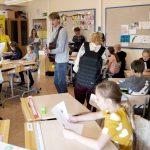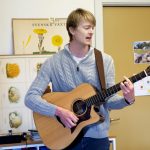Meet the Researcher: Christien Laber
2021-03-15
The MPEA research group is an international group of researchers with diverse research backgrounds, talents and interests. We welcome Christien into our group in 2020 as a lab technician, and he is now joining us as a post-doc in April, 2021. Christien’s background both as a scientist and a musician makes him uniquely situated to communicate our marine phytoplankton research to the world in a way that people and children understand. He has been essential to our AlgoKidz project, and continues to contribute to our work in outreach, research and beyond.
His blog, Music of Science, is dedicated to research communication through music.
 An interview with Christien Laber:
An interview with Christien Laber:
What is your background as a marine biologist? (your PhD dissertation, where you got your start?)
I have been studying phytoplankton for my entire career as a marine biologist but I have had varied interests since I first started working with them during my undergraduate studies. My first experience was working with a couple harmful algae bloom (HAB) forming species in the coastal oceans of the United States. The first was Karlodinium veneficum which is responsible for extensive fish kills that occur in the Chesapeake Bay and along the Eastern Seaboard of the United States. I was studying how these algae modulate their toxin production when grown in varying light conditions to help explain the variability of their toxicity in the environment. The other HAB I studied was Karenia brevis which is responsible for the infamous Florida red tide that closes beaches and cause respiratory and eye irritation. I worked on a project developing the discriminatory power of robots that optically detect special algal pigments used identify K. brevis among natural phytoplankton communities in the Gulf of Mexico and warn scientists of upcoming blooms.
For my PhD, I focused on an algae species many of us call the ‘rock star’ of the ocean, Emiliania huxleyi. The nickname comes from the ornate calcium carbonate plates that cover the cell called coccoliths. These liths are constantly produced and shed from cells and produce a beautiful chalky turquoise color in the water when the algae are blooming. The color is so distinct, that these blooms are easily observed from space and satellite images regularly show these swirling blooms extend for thousands of square kilometers. I was studying how these blooms can become infected by a virus specific to E. huxleyi, and what happens to the carbon that composes the billions of cells in these blooms when they lyse, and die during advanced infection events. The research that came out of my PhD provided some of the first evidence that algal viruses can increase the efficiency of carbon export out of the surface ocean and into the deep ocean. We suggested this process is stimulated by sticky polysaccharides produced by the cells as a byproduct of viral infection that stimulates the formation of quickly sinking aggregates of dead/dying cells and their coccoliths. And it’s been quite exciting to see other studies corroborate our evidence that viruses can stimulate flux as well, as its quite opposite of the suggested paradigm just a decade ago.
How does working in the States or other countries differ to working in Sweden?
So far, the things that stick out to me the most are the very international nature of our community and just how much vacation we get here! I think the emphasis on having a good work-life balance is very welcoming, and it’s good to have reminders now and then that Swedes take this seriously. In the US, I think many people are limited to getting 2 weeks paid vacation per year or less, which is quite unfortunate.
Here in Sweden, I have also really enjoyed getting to meet and work with so many people from so many different parts of the world! Working in the US, most of my colleagues were also Americans. Lovely as we Americans can be, I have been able to learn so much about working as a global citizen with colleagues who are largely also internationals.
You’re a great singer-songwriter! How did you develop your science communication music, how long have you been doing it?
I guess the idea of writing music about science, and oceanography in particular, first started coming to me late in my PhD when I was listening to a lot of Stan Rogers. He wrote some beautiful folk ballads about maritime travel, work, and lifestyle with exquisitely crafted lyrics that really pull you into the music. And so, as a musician, I started wondering if I could do something similar but describe the experience of doing science at sea instead. My first song was ‘The Pursuit of Knowledge’ which I wrote about the North Atlantic Aerosol and Marine Ecosystems Study (NAAMES) that I had recently participated in and served as a test of the concept. I didn’t know if the science would make a particularly compelling story or not, but when I was done I was quite happy with the end result. And I guess some others who were part of the NAAMES project also quite liked it, and so I threw together an accompanying video so that we could publish it for the public to see. The really fun part was that NASA (who funded the NAAMES study) caught on and decided to publish the music video on their social media platforms. So I very quickly got to see the music become an effective communication platform, and with some positive feedback decided to write a few more songs so far.
Word on the street is that you’re headed up to the Arctic this summer for a 3(2) month long research excursion. Tell us more!
Yes, I’m very excited about this. I will be going to the Arctic with several other members of our team to investigate picophytoplankton, the smallest photosynthesizing organisms on the planet, and their contribution to sustaining the marine ecosystem in the Arctic. We are conducting this study as part of the Synoptic Arctic Survey, an international study that will be making a comprehensive investigation of the current state of the Arctic ecosystem from 2020-2022 and assess how it is changing. Picophytoplankton make up an important fraction of the primary production that supports the arctic food web, but their distribution and diversity are still poorly characterized. As a rapidly warming and changing system, we also need to understand how the assemblage of picophytoplankton will change over the next century and impact ecosystem dynamics. So the sampling and experiments we will be conducting will try to provide some answers to these questions, as well as a good foundation for research going forward.
What are you most excited about for this excursion? Any nerves?
Well I suppose one can only hope to see a polar bear or two, but not get too close of course! Yes, I think I’m most excited to just absorb the remoteness of the area and the beauty of the sea ice and whatever little (or big) creatures are hanging out in the area as we travel through.
We will also be on the icebreaker research vessel Oden for the expedition, which may take us near the North Pole by cutting through sea ice. This will also be exciting, and I do have faith in the ship’s design, but it will perhaps also be a bit intimidating to have tons of sea ice pressing against the ship’s hull as we cruise along!
- We’re really happy to have you onboard. ? Welcome! (a bit belated!)
Thank you very much! Tack så mycket!
-Caroline Littlefield & Christien Laber





